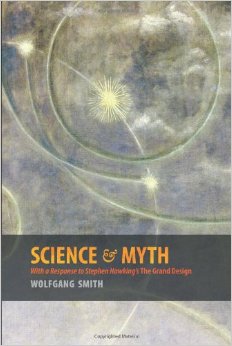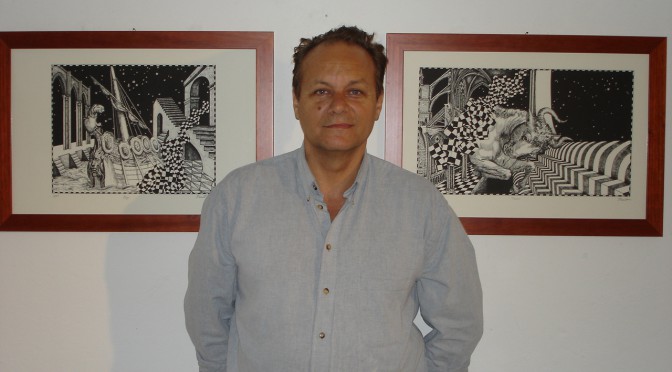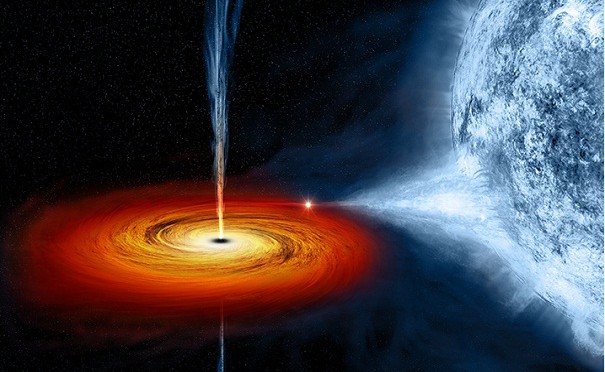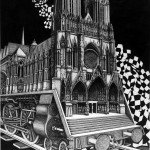Like the Italian artist and engraver Giovanni Battista Piranesi (1720-1778), whose follower he is, Jean-Pierre Luminet depicts space with passion and melancholy. By repeating ceaselessly black and white checkerboards, he evokes the notion of infinity and generates the dizziness of the glance. By disrupting the laws of classical perspective, he conjugates architectural immobility and time unsettledness. The artist immerses elements in a black ocean, and such a subtle interaction gives the sensation of perpetual time. Infinity is that aspiration felt by the man held on ground by gravitation. Jean-Pierre Luminet depicts this sensation by creating vanishing points towards which one feels irresistibly attracted.
Anne de Commines, Art criticsThe Rise of Big Bang Models (4) : Lemaître
Sequel of previous post : Dynamical solutions
In this series of posts about the history of relativistic cosmology, I provide an epistemological analysis of the developments of the field from 1917 to 2006, based on the seminal articles by Einstein, de Sitter, Friedmann, Lemaître, Hubble, Gamow and other main historical figures of the field. It appears that most of the ingredients of the present-day standard cosmological model, including the accelation of the expansion due to a repulsive dark energy, the interpretation of the cosmological constant as vacuum energy or the possible non-trivial topology of space, had been anticipated by Lemaître, although his papers remain mostly unquoted.
The discovery of expanding space
The 1920’s were precisely the time when the experimental data began to put in question the validity of static cosmological models. For instance, in 1924 the British theorist Arthur Eddington pointed out that, among the 41 spectral shifts of galaxies as measured by Vesto Slipher, 36 were redshifted ; he thus favored the de Sitter cosmological solution while, in 1925, his PhD student, the young Belgian priest Georges Lemaître, proved a linear relation distance-redshift in de Sitter’s solution. The same year 1925, Edwin Hubble proved the extragalactic nature of spiral nebulae. In other words, he confirmed that there existed other galaxies like our own, and the observable Universe was larger than previously expected. More important, the radiation from the faraway galaxies was systematically redshifted, which, interpreted as a Doppler effect, suggested that they were moving away from us at great speed. How was it possible ?
It was Lemaître who solved the puzzle. In his 1927 seminal paper Un univers homogène de masse constante et de rayon croissant, rendant compte de la vitesse radiale des nébuleuses extragalactiques, published in French in the Annales de la Société Scientifique de Bruxelles, Lemaître calculated the exact solutions of Einstein’s equations by assuming a positively curved space (with elliptic topology), time varying matter density and pressure, and a non-zero cosmological constant. He obtained a model with perpetual accelerated expansion, in which he adjusted the value of the cosmological constant such as the radius of the hyperspherical space R(t) constantly increased from the radius of the Einstein’s static hypersphere RE at t = – ∞. Therefore there was no past singularity and no « age problem ». The great novelty was that Lemaître provided the first interpretation of cosmological redshifts in terms of space expansion, instead of a real motion of galaxies : space was constantly expanding and consequently increased the apparent separations between galaxies. This idea proved to be one of the most significant discoveries of the century. Continue reading The Rise of Big Bang Models (4) : Lemaître
The Rise of Big Bang Models (3) : Friedmann’s Dynamical solutions
Sequel of previous post : Static Solutions
In this series of posts about the history of relativistic cosmology, I provide an epistemological analysis of the developments of the field from 1917 to 2006, based on the seminal articles by Einstein, de Sitter, Friedmann, Lemaître, Hubble, Gamow and other main historical figures of the field. It appears that most of the ingredients of the present-day standard cosmological model, including the accelation of the expansion due to a repulsive dark energy, the interpretation of the cosmological constant as vacuum energy or the possible non-trivial topology of space, had been anticipated by Lemaître, although his papers remain mostly unquoted.
The Friedmann’s pioneering work
 In an article which appeared in 1922, entitled On the Curvature of Space (see Luminet 2004 for reference and translation), the Russian physicist Alexander Friedmann took the step which Einstein had balked at : he abandoned the theory of a static universe, proposing a “dynamic” alternative in which space varied with time. As he stated in the introduction, “the goal of this notice is the proof of the possibility of a universe whose spatial curvature is constant with respect to the three spatial coordinates and depend on time, e.g. on the fourth coordinate.“
In an article which appeared in 1922, entitled On the Curvature of Space (see Luminet 2004 for reference and translation), the Russian physicist Alexander Friedmann took the step which Einstein had balked at : he abandoned the theory of a static universe, proposing a “dynamic” alternative in which space varied with time. As he stated in the introduction, “the goal of this notice is the proof of the possibility of a universe whose spatial curvature is constant with respect to the three spatial coordinates and depend on time, e.g. on the fourth coordinate.“

Thus he assumed a positively curved space (hypersphere), a time variable matter density and a vanishing cosmological contant. He obtained his famous “closed universe model”, with a dynamics of expansion – contraction. Continue reading The Rise of Big Bang Models (3) : Friedmann’s Dynamical solutions
The Rise of Big Bang Models (2) : Static solutions
Sequel of previous post : From Myth to Science
In this series of posts about the history of relativistic cosmology, I provide an epistemological analysis of the developments of the field from 1917 to 2006, based on the seminal articles by Einstein, de Sitter, Friedmann, Lemaître, Hubble, Gamow and other main historical figures of the field. It appears that most of the ingredients of the present-day standard cosmological model, including the accelation of the expansion due to a repulsive dark energy, the interpretation of the cosmological constant as vacuum energy or the possible non-trivial topology of space, had been anticipated by Lemaître, although his papers remain mostly unquoted.
The History of Relativistic Cosmology can be divided into 6 periods :
– the initial one (1917-1927), during which the first relativistic universe models were derived in the absence of any cosmological clue.
– a period of development (1927-1945), during which the cosmological redshifts were discovered and interpreted in the framework of dynamical Friedmann-Lemaître solutions, whose geometrical and mathematical aspects were investigated in more details.
– a period of consolidation (1945-1965), during which primordial nucleosynthesis of light elements and fossil radiation were predicted.
– a period of acceptation (1965-1980), during which the big bang theory triumphed over the « rival » steady state theory.
– a period of enlargement (1980-1998), when high energy physics and quantum effects were introduced for describing the early universe.
– the present period of high precision experimental cosmology, where the fundamental cosmological parameters are now measured with a precision of a few %, and new problematics arise (nature of the dark energy, topology of the universe, new cosmologies in quantum gravity theories, etc.)
Let us follow chonologically the rather hectic evolution of the ideas in the field. Continue reading The Rise of Big Bang Models (2) : Static solutions
Black Hole Imaging (2) : Heads and Tails
The thought experiments which have been described in my previous post Back to the basics are more than an intellectual exercise, because if black holes really exist (and we have strong observational arguments to believe that), then there is a good chance that they will be illuminated by a natural light source. For a black hole or a planet the most obvious form of lighting is a star. This star could, for example, be bound to the black hole in a binary system. Although such systems are common throughout our Galaxy, the corresponding black holes would be impossible to detect by this effect, as their image by reflected light would be drowned in the intense light of the direct image of the star itself.
A much more interesting situation from an observational point of view is when the source of light comes from a series of rings of matter in orbit around the black hole. It is believed that a number of black holes are surrounded by such structures, which are called accretion disks. Saturn’s rings are an excellent example of an accretion disk; they consist of amalgamated pieces of rock and ice which reflect the light of the distant Sun, whereas those of a black hole consist of hot gas brighting by itself (another important difference is that the accretion disk of a black hole is continually being supplied with gas, whereas that surrounding Saturn is the remnant of the primordial Solar System).

The gases fall slowly into the black hole, like water in a whirlpool. As the gas falls towards the black hole it becomes hotter and hotter and begins to emit radiation. This is a good source of light: the accretion rings shine and illuminate the central black hole. One can then ask : what would be the apparent image of the black hole accretion disk ? Continue reading Black Hole Imaging (2) : Heads and Tails
The Cosmos As A Poem
As an astrophysicist and a poet, I am apparently well-prepared to talk about cosmic poetry. However it is not so obvious. During many years I conducted these two activities quite independently – I mean scientific investigation of the nature of the universe through the study of relativity, black holes, cosmology, topology, and poetic writing. I even refuted any relationship between these two ways of apprehending the world.
I began to publish poetry 30 years ago, at the same epoch when I also published my first scientific works, however my poetic works had nothing to do with astronomy. For me, poetry had to express feelings, emotions, and subjects that cannot not be reached by rational investigation, such as love, death, beauty, loneliness, despair, and so on.
 |  |
 |  |
Black Hole Imaging (1/3): Back to the basics
The centre of the black hearth,
of setting suns on the shore :
ah ! well of magic
Arthur Rimbaud (Illuminations)
As probably all of you already know, the Interstellar movie tells the adventures of a group of explorers who use a wormhole to cross intergalactic distances and find potentially habitable exoplanets to colonize. For the scientific part, the film director, Christopher Nolan, has collaborated with a colleague of mine, the famous physicist Kip Thorne, a specialist in general relativity and black hole theory.
With such a scientific consultant, the promotion of the movie insisted a lot on the realism of the black hole images calculated by Kip Thorne and the team of visual effects company Double Negative. The most striking one shows a glowing accretion disk appearing above, below and in front of the black hole.

As soon as the movie was displayed on the screens, a lot of physics blogs have commented in details the “Science of Interstellar”. Kip Thorne himself has published a such entitled popular book, to explain how he tried to respect scientific accuracy despite the sometimes odd demands of Christopher Nolan, ensuring in particular that the depictions of black holes and relativistic effects were as accurate as possible.
 Since, as soon as 1979, I was the first researcher to perfom numerical calculations and publish the simulated image of a black hole surrounded by a thin accretion disk (you can upload the technical article here), to inaugurate this new blog I’ll devote a series of 3 posts to the basics of black hole imaging. A good part is adapted from a chapter of one of my books, published in French in 2006, Le destin de l’univers – unfortunately not yet available in English. Continue reading Black Hole Imaging (1/3): Back to the basics
Since, as soon as 1979, I was the first researcher to perfom numerical calculations and publish the simulated image of a black hole surrounded by a thin accretion disk (you can upload the technical article here), to inaugurate this new blog I’ll devote a series of 3 posts to the basics of black hole imaging. A good part is adapted from a chapter of one of my books, published in French in 2006, Le destin de l’univers – unfortunately not yet available in English. Continue reading Black Hole Imaging (1/3): Back to the basics
Luminet’s Illuminations
Luminet’s reinstated visualization of a finite Universe, albeit one from which we can exit through one face and simultaneously enter through the opposite one, relies upon a keplerian form of mental sculpture that may be described as plastic rather than algebraic. Luminet’s characteristic lithograph, Big Bang, exploits the spatial vocabulary of perspective to evoke realms beyond the three dimensional. Whereas Escher relied on contradictions and oscillating ambiguity in his graphic art, Luminet suggests plunging, interpenetrating and matter organizes itself into structures on the right; the tumbling dice on the left imply irreversible disorganization arising from chance. The remarkable range of Luminet’s creativity in art and science is integral to his agenda to recreate what he calls a « humanism of knowledge » — not that the arts and sciences are somehow to be conflated, because they work in very different ways, with illogical and logical means. But Luminet argues that they well up from the same instincts and intuitions: « I do not believe that we acquire at the beginning the ‘heart of an artist’ or the ‘heart of a scientist’. There is simply within oneself a single devouring curiosity about the world. This curiosity pushes us to explore it through various languages and modes of expression, » he says.
Martin Kemp, professor of the history of art at the University of Oxford. Excerpt from “Luminet’s Illuminations : Cosmological Modelling and the Art of Intuition”, Nature, 20 november 2003, vol. 426, p. 232
The Rise of Big Bang Models (1) : from Myth to Science
In this series of posts about the history of relativistic cosmology, I’ll provide an epistemological analysis of the developments of the field from 1917 to 2006, based on the seminal articles by Einstein, de Sitter, Friedmann, Lemaitre, Hubble, Gamow and other main historical figures of the field. It appears that most of the ingredients of the present-day standard cosmological model, including the accelation of the expansion due to a repulsive dark energy, the interpretation of the cosmological constant as vacuum energy or the possible non-trivial topology of space, had been anticipated by Lemaitre, although his papers remain mostly unquoted.
From Myth to Science
What are the origins of the universe, of the stars, of the earth, of life, of man? These questions have given rise to many different myths and legends, and today they are more than ever the subject of intensive research by astrophysicists, biologists and anthropologists. What were once fanciful stories are now scientific models; but whatever form they take, ideas about the origins of the universe both reflect and enrich the imagination of the people who generate them. Every society has developed its own stories to explain the creation of the world; all of them are ancient myths rooted in religion.
Whereas in monotheistic religions God is believed to have existed before the Creation, in most other kinds of religion the gods themselves are thought to originate from a creative element such as Desire, the Tree of the Universe, the Mundane Egg, Water, Chaos or the Void.

A belief in some such primordial element, of which there are traces in every culture, underlies man’s thinking about the history of the cosmos like a primitive universal symbol buried in the collective subconscious. This may explain the vague links that can always be discerned between this or that creation myth and modern scientific descriptions of the origin of the universe –for example, big bang theory. There is therefore nothing mysterious or surprising about these correspondences other than that certain ways of thinking about the world should be so ingrained in the human mind.

In fact scientific and mythical explanations of the origins are neither complementary not contradictory; they have different purposes and are subject to different constraints. Mythical stories are a way of preserving collective memories, which can be verified neither by the storyteller nor by the listener. Their function is not to explain what happened at the beginning of the world but to establish the basis of social or religious order, to impart a set of moral values. Myths can also be interpreted in many different ways. Science, on the other hand, aims to discover what really happened in historical terms by means of theories supported by observation. Often considered to be anti-myth, science has in fact created new stories about the origin of the universe: big bang model, the theory of evolution, and the ancestry of mankind. It is therefore hardly surprising that the new creation stories developed by scientists tend to be regarded by the general public as modern myths.
Continue reading The Rise of Big Bang Models (1) : from Myth to Science
Welcome on e-luminesciences
I like to share my various interests for science, art, literature and many other fields. As there are already a lot of excellent blogs devoted to astrophysics, physics, general relativity, cosmology, etc., this one will be more specifically devoted to « scientific culture », trying to cover some of my fields of interest and activity at the intersection of science, history, literature, art, philosophy.
This anglophone blog, « e-luminesciences », is NOT a translation of my francophone blog «luminesciences» (https://blogs.futura-sciences.com/luminet/, that I recommend to all the lovers of French culture), since it will present original posts as well as some ones adapted from their French version.
Have a nice time !
Quote by Newton
I do not know what I seem to the world, but to myself I appear to have been like a boy playing upon the seashore and diverting myself by now and then finding a smoother pebble or prettier shell than ordinary, while the great ocean of truth lay before me all undiscovered.
Isaac Newton, English philosopher and physicist, 1727
Quote by Tsiolkovsky
To set foot on the soil of the asteroids, to lift by hand a rock from the Moon, to observe Mars from a distance of several tens of kilometers, to land on its satellite or even on its surface, what can be more fantastic? From the moment of using rocket devices a new great era will begin in astronomy: the epoch of the more intensive study of the firmament.
Konstantin E. Tsiolkovsky, Father of Russian Astronautics, 1896























